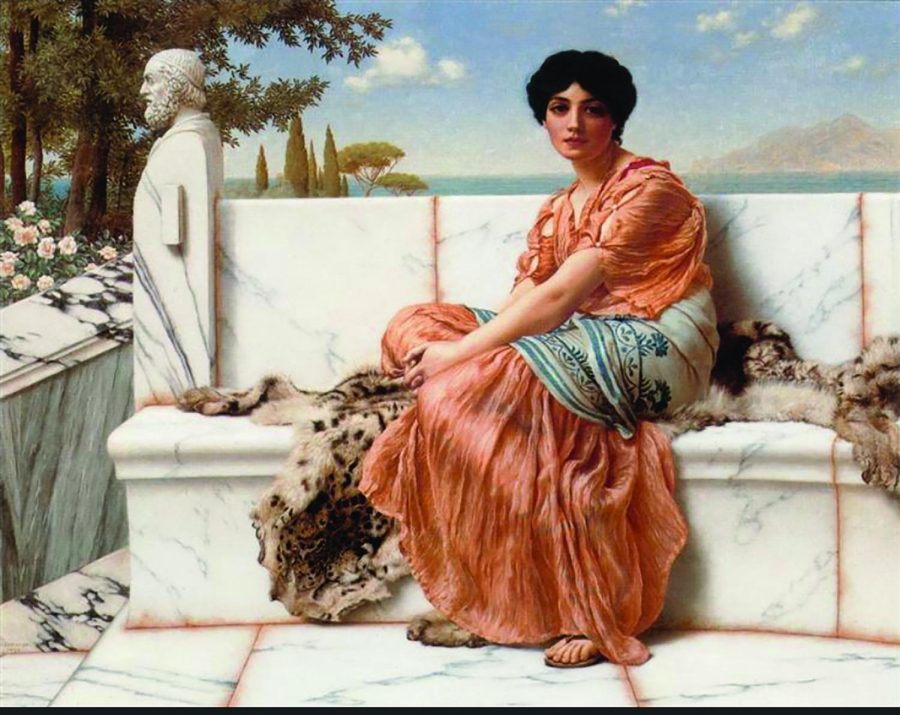Oscar Wilde and his Green Carnations:
Oscar Wilde was a notable playwright, novelist, poet, and celebrity in late nineteenth century London. According to “This Day in History: Oscar Wilde”, Wilde dressed in a flamboyant manner with a cutting wit and an “eccentric lifestyle [that] often put him at odds with the social norms of Victorian England.” The green carnation became a queer symbol in 1892 when Wilde instructed his friends to wear them on their coats the opening night of his comedy the “Lady Windermere’s Fan.” From that day forward, wearing a green carnation was a closeted secret, but a subtle hint of being a man who loved men. Additionally, in 1892, Wilde’s secret lover and his ultimate Judas to his Jesus, Lord Alfred Douglas who was a British aristocrat, wrote a poem titled “Two Loves”. The poem paints a flower-filled utopia and is heavily reminiscent of Sappho’s flower filled fragments of queer love. Sadly, Douglas made his and Wilde’s affair public in which sparked Wilde’s gross indecency trial in 1895 (homosexuality was a criminal offense during this time in England), where Douglas dared to utter the phrase from “Two Loves” saying “I am the love that dare not speak its name.”
A Streak of Lavender:
Lavender seemingly has always had a connection to the LGBTQ community. According to JSTOR Daily, one of the most notable uses of lavender roots comes from the historian Carl Sandburg, who in 1926, wrote of Abraham Lincoln: “A streak of lavender ran through him; he had spots soft as May violets.” In which many interpreted this to shed more light on Lincoln’s queer side, which has been an ongoing theory, due to Lincoln’s intimate relationship with Joshua Fry Speed – Lincoln wasn’t the only president to have queer relationships. Additionally, there were two movements that are associated with lavender: the Lavender Scare and the Lavender Menace. The Lavender Scare of the 1950s was a mass witch hunt for homosexual federal employees, which was very similar to the Red Scare for communists. For the Lavender Menace in 1969, Betty Friedan called the potential association of the National Organization for Women with lesbians the “lavender menace.” To not tarnish her organization’s reputation, she distanced NOW away from lesbians, which didn’t stop Rita Mae Brown and other lesbian feminist activists who took action on May 1st of 1970. Brown and others disrupted a prominent women’s event wearing T-shirts that said “Lavender Menace” and they encouraged others to join in. They earned the crowd’s support, and this moment is remembered as the turning point in the movement. At the NOW’s next national conference in 1971, the organization altered its direction and adopted a resolution that named lesbian rights as a legitimate concern for feminism.
Lavender also has its deep types of sapphic love, which can be seen through the character Violet in the lesbian cult classic movie “Bound.” However, a notable group associated with lavender was New York City’s “The Violet Quill.” In the 80s there were seven gay men who were writers – “The Violet Quill” had eight official meetings over one-year, as well as unofficial meetings, to read and critique each other’s work. For more information on the interactions and writing of “The Violet’s Quill”, visit the JSTOR Daily for the journal article on the “Race and the Violet Quill”. Another example is the 1926 play “The Captive”, a woman character sends violets to another woman, possibly referring to Sappho. However, the theme of lesbianism in the play led to mass uproar, boycotts, and censorship. Sadly, the New York City district attorney gave into the uproar and shut down all production in 1927. The association of violets with lesbianism from the play led to plummeting violet sales in US flowers, however, during the showings in Paris, some women wore the flower on the side of their coats to show support.
Sapphic Violets of Sappho’s Poems:
The correlation between flowers and queer people can be dated back to Sappho, who is labeled as the world’s first known woman-loving woman. According to JSTOR Daily, Sappho was “a Greek poet who lived on the island of Lesbos,” which is extremely close to Turkey’s border to where you can see it from the shore of the island. Any person from the island of Lesbos is a Lesbian, but Sappho’s profound presence spawned the lowercase-L lesbian that we know today. In fact, in 2008, Lesbian islanders had sued for the right over the word and ultimately lost. Sadly, only fragments of Sappho’s works remain, but it is known that her ancient poetry contains references to the beauty of flowers and nature – which paints pictures of blissful pastures where women frolicked in fields of flowers. In her poems, Sappho references roses, violets, honey clovers, a lotus, crocuses, and hyacinth in particular, but she always tends to mention the color purple or violet multiple times.
The “Pansy Craze” of Pansy Flowers:
From the “Flowers of Manhood”, daisies, buttercups, and especially the pansies were used in the early twentieth century to describe “flamboyant gay men.” In the 20s and 30s, underground drag dance balls were very popular at the time, especially in major cities. The drag performers were known as “pansy performers” and at the time, pansy was supposed to be in reference to the colorful clothing they used which dubbed the period as the “Pansy Craze.” However, after Prohibition many of the clubs were shut down, but the word pansy continued to be used about gay men, often in a derogatory way. Likewise, Hollywood’s “pansy craze” of queer representation in film was ultimately censored, but not before the movies helped bring out queerness to national consciousness. Some good news is that LGBTQ activists are using pansies in a queer-affirming way! Notable activist, Paul Harfleet, who founded “The Pansy Project” that’s meant to plant pansies at sites of transphobic or homophobic discrimination. The bright blooms are to provide hope for the flourishing community!


